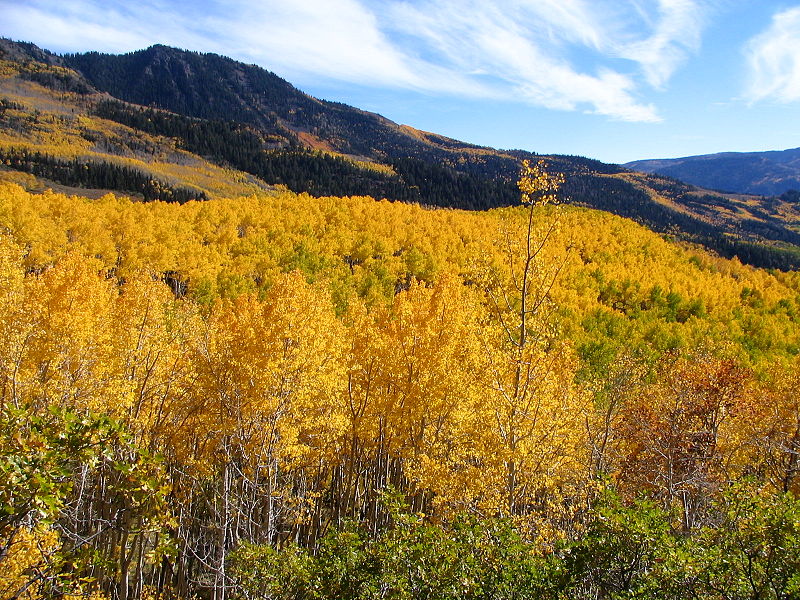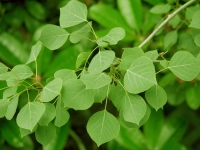 Populus tremuloides has the largest natural range of any tree native to North America, and the third largest natural range of any species of tree in the whole wide world. Quaking aspen grows all the way from the east coast to the west coast, and its range extends from Guanajuato, Mexico in the south to the very northern limit of tree growth in Canada. That figure might not sound impressive at first blush, but think of how amazingly adaptable quaking aspen has to be to survive in all of the different habitat types that exist within such a huge range. It would have to be able to survive extremely hot and extremely cold weather, wildly different moisture regimes, urban space and wilderness, different species of pollinators and foragers, different elevations, soil types, and on and on and on. In fact, the only major limiting factor to the range of quaking aspen is that it grows primarily where annual precipitation exceeds annual evapotranspiration. That is to say, quaking aspen mostly grows where there is more moisture in rain or snowfall each year than the plants in that area can use or that evaporates naturally into the atmosphere.
Populus tremuloides has the largest natural range of any tree native to North America, and the third largest natural range of any species of tree in the whole wide world. Quaking aspen grows all the way from the east coast to the west coast, and its range extends from Guanajuato, Mexico in the south to the very northern limit of tree growth in Canada. That figure might not sound impressive at first blush, but think of how amazingly adaptable quaking aspen has to be to survive in all of the different habitat types that exist within such a huge range. It would have to be able to survive extremely hot and extremely cold weather, wildly different moisture regimes, urban space and wilderness, different species of pollinators and foragers, different elevations, soil types, and on and on and on. In fact, the only major limiting factor to the range of quaking aspen is that it grows primarily where annual precipitation exceeds annual evapotranspiration. That is to say, quaking aspen mostly grows where there is more moisture in rain or snowfall each year than the plants in that area can use or that evaporates naturally into the atmosphere.
Quaking aspen is an early-successional or pioneer species, which means that it is one of the first tree species to colonize an area that was previously disturbed. They gradually phase out of the forest as other species move in and shade them out. They grow very quickly and reproduce both sexually and through cloning. Aspen trees as young as one year old are already able to clone themselves by sending up a sister (or brother) tree off of their roots. In fact, in Fishlake National Forest in Utah, a massive clone of Populus tremuloides (confirmed as one individual by DNA testing) covers 170 acres and has over 47,000 stems all of which share one massive root system. This massive individual is referred to as the Pando clone ("Pando" is Latin for "I spread"...fitting, right?) Each stem of the Pando clone grows and dies back, but the root system has survived for at least 80,000 years! The Pando clone may be the single largest organism in the world: there has been a raging debate since 1992 among those folks who debate about such things as to whether the Pando clone or a fungal colony in the mountains of Oregon is actually the largest organism in the world.

Pure stands of Populus tremuloides are a favorite for hunters because they provide food and habitat for a wide variety of wildlife like black bear, deer, elk, ruffed grouse, beaver, rabbits, and a bunch of different species of smaller mammals and birds, not to mention many species of insects, butterflies, and moths. In fact, the amount of forage created by a pure aspen stand can be more than twice that created each year by neighboring coniferous forests.
Another super interesting fact about the importance of quaking aspen stands for the survival of wildlife—in the western part of the country where forest fires are more common and often catastrophic, wildlife will actually retreat into the center of large pure stands of Populus tremuloides to wait out the fire! Quaking aspen stands accumulate relatively little fuels (dead leaves and fine branches) so a raging forest fire will slow down and smolder slowly through the stand or die away. The aspen stand provides a refuge in a forest fire for those wildlife that can get there and wait out the fire.
Would you like to check out a quaking aspen in person? Come to our Riverside Park Urban Ecology Center location and check out our three young quaking aspens that are growing just northwest of the building above our climbing wall. Or go to our new Menomonee Valley location and look at the several that are behind the building near the connection to the Hank Aaron Stat Trail. They look very beautiful this time of year as their catkins (fruiting structures) open up and look like little fluffy ball of grey velvet on the end of each twig.





